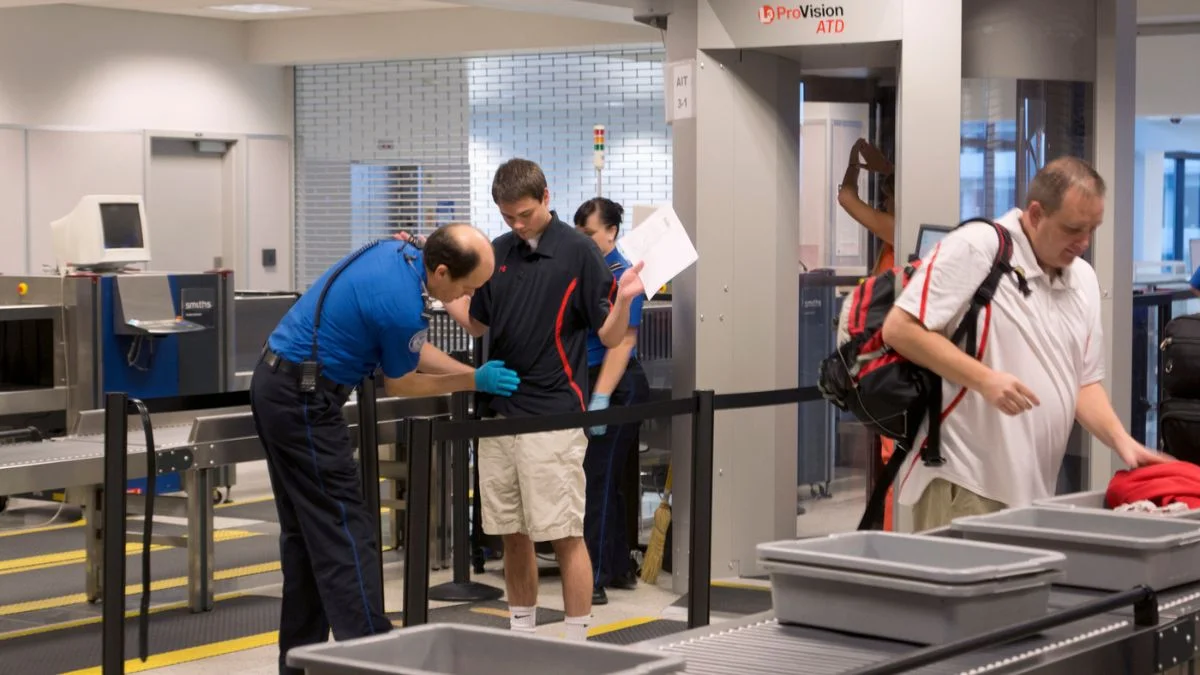What Can Airport Body Scanners See? Uncovering Every Detail

As participants in Amazon Associates and other programs, we earn from qualifying purchases. This comes at no additional cost to you. For more details, see our Affiliate Disclosure.
Traveling by air often requires a dance with security measures, with the airport body scanner taking center stage. For many, the mystery of what these machines can actually see under the layers of clothing is a topic of both curiosity and concern. In this article, we will unveil every detail about the capabilities of airport body scanners, answering your most pressing questions and demystifying the process.
Do Airport Body Scanners See Through Clothes?
Airport body scanners, commonly found in many international airports, are designed to “see” through clothing to identify potential threats or prohibited items. The primary purpose is not to view the body but to spot concealed objects.
These machines use advanced imaging technology to produce a generic outline of a person, highlighting any concealed items. It’s important to note that the images produced are not detailed photographs of the individual but rather stylized representations to preserve privacy.
There are two main types of scanners in use: millimeter wave scanners and backscatter X-ray scanners. Both create images by bouncing waves or rays off the body, but they don’t produce detailed or invasive images of a person’s body underneath clothing. Instead, they show the location of objects that are not part of the body.
To further protect individual privacy, many modern scanners blur facial features and sensitive body areas or use software that displays a generic figure rather than the specific outline of the person being scanned.
Can Airport Scanners See Through Shoes?
Yes, airport scanners are designed to see through shoes to identify concealed items that may pose a security risk. The walk-through metal detectors, commonly encountered at the primary security checkpoint, can detect metal objects in shoes.
That’s why, in many security procedures across airports worldwide, passengers are often asked to remove their shoes and place them on the X-ray conveyor belt system. This separate X-ray scan provides a detailed view of the shoes and their contents, helping security personnel identify objects of concern, such as knives, sharp objects, or even certain explosive materials.
While the U.S. and certain other countries often require passengers to remove their shoes for scanning, some nations and specific security programs may not have this requirement, especially with the advancement in scanner technology.
Newer scanning machines, particularly the advanced imaging technology (AIT) scanners, can thoroughly scan shoes while they are still worn. However, removing shoes can provide a clearer, unobstructed view, ensuring both efficiency in the screening process and the safety of all travelers.
How Do Airport Body Scanners Differentiate Between Organic And Inorganic Materials?
Airport body scanners employ advanced imaging technologies that allow them to differentiate between organic and inorganic materials based on the way these materials interact with the scanning waves or rays. The distinction between these materials is crucial as it helps security personnel identify potential threats.
Millimeter wave scanners, for instance, use electromagnetic waves that bounce off the body and any concealed objects. Organic materials (like clothing, food, or the human body) and inorganic materials (like metals or plastics) reflect these waves differently. The scanner then processes this information to produce an image with contrasting shades or colors to highlight potential items of concern.
Similarly, backscatter X-ray scanners emit low-level X-rays that reflect off objects and back to the machine. Organic materials will typically appear as lighter areas on the scan, while inorganic items, especially metals, appear darker or more solid.
To assist security personnel, many modern scanners use automatic threat detection software that identifies and highlights potential threats on the screen. This software analyzes the properties of detected items and uses color or shape-based indicators to draw attention to objects that might be of interest, thereby making the screening process more efficient and accurate.
Can Airport Body Scanners See Inside You?
Airport body scanners are designed to identify objects on the surface of the body and those concealed under clothing, but they are not medical imaging devices and cannot see inside the body in the way a CT or MRI scan can.
They create an outline or silhouette of a person and show objects not part of the body. While they can detect items underneath clothing, they do not provide detailed imagery of internal organs or structures.
Can Airport Body Scanners See Tampons?
Airport body scanners might detect tampons or other internal items, but they won’t specifically identify them as tampons. Instead, they might appear as an anomaly or a region of interest. However, security personnel are trained to recognize common non-threat items and differentiate between potential risks.
It’s important to remember that the primary objective of these scanners is security, and common personal care items are not their focus. If a scan does raise a concern, a private, respectful pat-down may be offered, and passengers can always request a private screening.
Can Airport Body Scanners See Pads?
Yes, airport body scanners can detect sanitary pads as they can with other external objects. However, much like tampons, these items usually won’t raise alarms as security personnel are familiar with such common non-threatening items.
If the scanner highlights the area, a quick pat-down might be performed for clarification, ensuring no prohibited items are present.
Can Airport Body Scanners See Drugs?
Airport body scanners are primarily designed to identify potential threats like weapons or explosives. While they can detect anomalies or objects concealed under clothing, they aren’t inherently designed to identify drugs.
However, if drugs are concealed on the body, they may appear as an unknown object. The specific identification of such objects often requires additional screening methods or equipment, such as sniffer dogs or chemical swabs.
Can Airport Body Scanners Detect Pills?
Pills in their typical packaging (like a pill bottle or blister pack) can be detected by the X-ray machines that scan carry-on baggage. When it comes to body scanners, small quantities of pills, especially if they are in a pocket or held against the body, might be detected, but they would not be identified as medications.
The scanner would only show the presence of an unknown object. If there’s any doubt or uncertainty from the scanner’s imagery, security personnel might request additional screening or ask passengers about the items in question.
Can Airport Body Scanners See Liquids?
Yes, airport body scanners can detect liquids. This capability is particularly significant since liquid explosives became a concern. In fact, the distinct scanners used for carry-on bags are specifically designed to identify and differentiate between various types of liquids to assess their threat level.
If a passenger has a bottle or other container with liquid against their body, the body scanner will highlight it as an area of interest. This is one reason travelers are often asked to remove items from pockets and declare larger quantities of liquids separately at security checkpoints.
Can Airport Body Scanners Detect Tumors?
No, airport body scanners are not designed to detect tumors or any other medical conditions. These scanners focus on identifying items on or close to the skin surface and aren’t capable of the detailed internal imaging required to spot tumors.
Medical imaging devices, such as MRIs or CT scanners, are specifically designed for this purpose, whereas airport scanners prioritize security concerns.
Can Airport Body Scanners Detect IUD?
Intrauterine devices (IUDs) are typically made from plastic with a small amount of metal (often copper). While the metal in an IUD could be detectable, it’s often too small and positioned in such a way that it doesn’t trigger alarms on a body scanner.
However, even if it were detected, security personnel are trained to understand and recognize common, non-threatening items, and an IUD would not be a cause for concern.
Can Airport Body Scanners Detect Metal Implants?
Yes, metal implants, such as surgical screws, hip replacements, or plates, can be detected by airport body scanners, especially if the metal’s mass is significant. The scanners are designed to identify metals and other materials that could pose a threat. If you have a metal implant, it might be helpful to inform the security personnel in advance.
In some cases, a pat-down or additional screening might be conducted to verify the source of the detected metal, but having documentation about medical implants can help clarify things quickly.
Can Airport Body Scanners See Prosthetics?
Yes, airport body scanners can detect prosthetics as they can identify objects and materials that are not part of the natural body. It’s always a good practice for travelers with prosthetics to inform security personnel beforehand to ease the screening process.
While prosthetics will show up on the scanner, security agents are trained to recognize them and differentiate between prosthetics and potential threats. Some travelers with prosthetics might undergo an additional pat-down or screening, but it’s always done with respect and understanding.
Can Airport Body Scanners Detect Breast Implants?
Airport body scanners can detect objects that differ from the expected human anatomy, and this includes breast implants. However, these scanners don’t produce detailed images of the body’s internals; instead, they create an outline or silhouette. Breast implants, being under the skin and designed to feel similar to natural tissue, won’t typically stand out in the way concealed objects on or close to the body’s surface might.
Security personnel are also trained and familiar with a wide range of common medical augmentations, including breast implants. As such, while implants might be “visible” in a sense on a scanner, they are not a cause for concern and won’t typically result in additional screening.
Can Airport Body Scanners See Hidden Electronics?
Yes, airport body scanners are designed to detect a wide range of materials, including the metals and components commonly found in electronics. If someone tries to conceal electronics on their body or inside clothing, the scanner will highlight this area due to the differences in material properties compared to the human body.
This is especially crucial for security personnel as hidden electronics could potentially be used for malicious purposes. It’s worth noting, however, that everyday electronics like phones, tablets, or laptops, when screened separately as per standard protocol, won’t raise concerns.
Are There Materials That Airport Body Scanners Can’t Detect?
While airport body scanners are impressively advanced and can detect a broad range of materials, no technology is infallible. Some materials can be more challenging for these scanners to detect due to their composition, size, or placement.
- Low-density materials: Materials that are very similar in density to human tissues might not stand out prominently on the scanners. This includes certain types of plastics or gels.
- Very thin metals: Extremely thin sheets of metal that lie flat against the skin might not be detected as easily, especially if they’re oriented in a way that minimizes reflection or absorption of the scanning waves.
- Certain fabrics: Some non-metallic materials, especially if they’re thin and conform well to the body, might be less noticeable. However, this largely depends on the technology being used.
- Organic materials: Items made purely from organic materials, especially if they’re of a similar density to the human body, could be harder to detect. This could include food items or wooden objects.
- Smaller objects: The size and location of an object play a role in its detectability. Very small objects, especially if they’re placed in areas where the scanner’s resolution is less detailed, might be overlooked.
It’s worth noting that while certain items might be harder to detect, the combination of different security measures, including manual pat-downs, enhances the likelihood of spotting concealed items.
How Accurate Are Airport Body Scanners In Identifying Threats?
Airport body scanners have become a cornerstone of airport security due to their efficacy in identifying potential threats. These devices employ advanced imaging technologies to detect a wide array of concealed objects, both organic and inorganic.
Their accuracy is high, especially with the newer models that combine different scanning methods and utilize sophisticated software algorithms. This ensures they identify potential threats with minimal false negatives (overlooking a genuine threat). However, like any technology, they are not without their limitations.
False Positives: One of the challenges has been the occurrence of false positives. This happens when the scanner flags an object that isn’t a threat, perhaps due to its shape, material, or location. An example might be certain medical implants or even folds in clothing.
Operator Dependence: The efficacy of these scanners is also somewhat reliant on the operators. Trained personnel must interpret the results, and human error can occasionally come into play.
Software Limitations: While software algorithms help identify threats, they aren’t perfect and sometimes require updates to handle new or unique situations.
Complementary Measures: To enhance their accuracy, body scanners are often paired with other security measures, such as manual pat-downs, X-ray bag scans, and sniffer dogs. This multi-layered approach ensures that even if one method misses a potential threat, another might catch it.
While airport body scanners are highly accurate in identifying threats, their effectiveness is maximized when they operate in tandem with other security measures and are overseen by well-trained personnel.
Do Airport Body Scanners Use X-rays Or Millimeter Waves?
Airport body scanners primarily utilize two main technologies: backscatter X-rays and millimeter waves.
Backscatter X-ray scanners emit low-level X-rays to produce an image, where materials that absorb the rays (like metals) appear darker, while those that reflect (like organic materials) appear lighter.
On the other hand, millimeter-wave scanners use non-ionizing electromagnetic radiation, similar to that in wireless networks, to produce a three-dimensional image based on the energy reflected from the body and concealed items.
Are Airport Body Scanners Harmful To Your Health?
The amount of radiation emitted by backscatter X-ray scanners is exceedingly low, often compared to the amount of radiation one would be exposed to during just a few minutes of a typical flight.
Millimeter-wave scanners, using non-ionizing radiation, have been deemed safe and fall well within established health and safety standards. In essence, for the general population, the health risks associated with these scanners are minimal and are considered safe for everyday use.
How Safe Are Airport Body Scanners For Pregnant Women?
Both backscatter X-ray and millimeter-wave scanners are believed to be safe for pregnant women. The radiation dose from a backscatter scanner is extremely low, much lower than the natural background radiation a person encounters daily.
Millimeter-wave scanners use non-ionizing radiation, which doesn’t pose the same risks as ionizing radiation. However, as a precautionary principle, some pregnant women may choose to opt for a manual pat-down instead of scanner screening, which is typically allowed at many airports.
Can Airport Body Scanners Detect Pregnancy?
Airport body scanners are not designed to detect pregnancy. Their primary function is to identify potential threats or concealed items on a person.
While they create images or silhouettes that show items on or under clothing, they do not provide detailed imagery of internal organs or structures, including the womb or a fetus.
Can Airport Body Scanners Detect Medical Devices Like Pacemakers?
Yes, airport body scanners can detect medical devices, including pacemakers, due to the materials used in these devices. However, the scanners won’t harm or interfere with the operation of the device.
If you have a pacemaker or other medical implant, it’s a good idea to inform the security personnel in advance. Often, individuals with certain medical devices are given the option of a pat-down or alternative screening method to avoid any potential issues or misunderstandings.
How Do Airport Body Scanners Impact Personal Privacy?
Airport body scanners have sparked concerns over personal privacy since their introduction. Earlier models produced detailed images of the body, which raised privacy issues as they could reveal intimate body details. In response to these concerns, newer scanner models and software have been developed to show a generic silhouette or avatar, highlighting only areas where potential threats or anomalies are detected.
This approach minimizes invasive visuals while still ensuring security. Additionally, the images produced are typically viewed in a remote location, so the agent assisting the passenger cannot see the image, and they are not stored or recorded, further safeguarding individual privacy.
How To Opt-out Of An Airport Body Scanner?
If a traveler has concerns about passing through a body scanner, most airports in the U.S. and many around the world allow passengers to opt-out. Those who choose this option will undergo an alternative screening method, typically a manual pat-down.
It’s essential to communicate the desire to opt-out clearly to security personnel before entering the scanner. While the pat-down is more hands-on and can be time-consuming, it serves as an effective alternative for those with health concerns, privacy issues, or other personal reasons.
How Have Airport Body Scanners Evolved Over The Years?
The evolution of airport body scanners has been driven by a combination of technological advancements and public feedback. Initially, many scanners produced detailed images of passengers’ bodies, raising privacy concerns.
In response, newer models use software to generate generic avatars with highlighted anomalies, thereby protecting individual privacy. Technological improvements have also led to faster scan times and increased accuracy. Additionally, as threats to aviation security have evolved, so have the capabilities of scanners.
They now offer better detection of a wider range of materials and objects, from metals to organic materials. Over time, these advancements aim to strike a balance between ensuring public safety and respecting individual rights and comforts.






